After the new Patent Law (the fourth revision) has been implemented for more than two years, the corresponding new Implementing Regulations of the Patent Law and the new Patent Examination Guidelines (hereinafter referred to as the "new Guidelines") were implemented as of January 20, 2024. The specific operating rules for the partial design system first raised in the fourth revision of the Patent Law have finally been issued by the new Guidelines.
This article systematically sorts out several main points related to a partial design provided in the new Guidelines based on a comparison with a whole design. Anyway, more time is needed to accumulate the specific practice of partial design and more judicial precedents to provide specific guidance.
I. Basic Concept of Partial Design
Partial design in the Patent Law means any new design of the shape, the pattern, or their combination, and the combination of the colour with the shape or pattern of a product, which creates an aesthetic feeling and is fit for industrial application. If it is required to protect an indivisible part of a product, the application shall be submitted in the form of a partial design.
1. The partial design of a product may not protect the pattern or the combination of pattern and colour applied on the surface of the product.
According to the provisions of the new Guidelines, there are differences in the protectable design elements between the whole design and the partial design of a product. The specific comparison is as follows.

In other words, designs of pattern or combination of pattern and colour on the surface of a physical product cannot be protected through partial designs.
Figures 1-1 to 1-3 respectively show examples of the whole and partial designs of a cup with surface patterns.
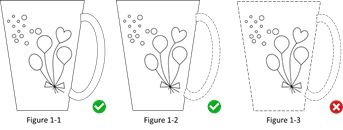
Figure 1-1 shows a whole design for protecting the combination of the shape and the pattern of the cup.
Figure 1-2 shows a partial design for protecting the combination of the shape and the pattern of the cup.
Figure 1-3 shows a partial design for protecting the surface pattern of the cup body (not allowed).
Among them, the pattern on the surface of the cup body as shown in figure 1-3 cannot be protected by a design patent.
Based on similar rules, for a plane product such as printed cloth or wallpaper, the pattern or the combination of pattern and colour should usually be protected by a whole design rather than a partial design. That is to say, partial design may not protect the pattern or the combination of pattern and colour on a plane product.
Figures 2-1 to 2-3 respectively show examples of designs of a plane product. The view representation shown in figures 2-2 and 2-3 may not be granted design patents as prescribed.
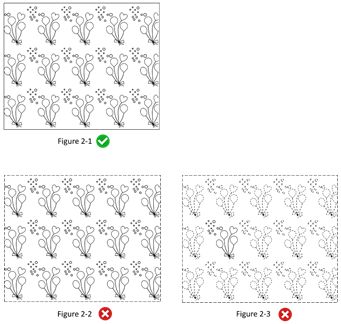
Figure 2-1 shows a whole design for protecting the combination of shape and pattern on a plane product (such as printed cloth);
Figure 2-2 shows a partial design for only protecting the pattern on a plane product (not allowed);
Figure 2-3 shows a partial design for only protecting a pattern unit on a plane product (not allowed).
2. For partial design, it is needed to form a relatively independent area on the product or constitute a relatively full design unit.
According to the new Guidelines, for example, a turning line on a handle of a cup, or an irregular portion of lens of glasses arbitrarily cut cannot form a relatively independent area or constitute a relatively full design unit, and thereby cannot be protected by partial design.
Below, the explanation is given through the examples shown in figure 3-1 to figure 3-4.
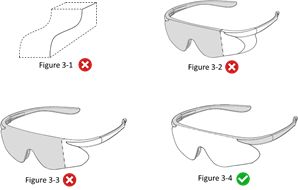
Figure 3-1 shows a partial design for protecting an edge which does not form an independent area (not allowed).
Figure 3-2 shows a partial design for protecting a part shown by solid lines without a clear physical imaginary boundary between the claimed part (i.e., the part to be protected) and the disclaimed part (i.e., the part not to be protected), failing to clearly illustrate a relatively independent area (not allowed).
Figure 3-3 shows a partial design for protecting one leg of glasses and a randomly cut -out part of the lens of glasses, wherein the portion covered with a gray translucent colour block is the disclaimed part, and then the claimed part does not form a relatively independent area or is relatively full design unit (not allowed).
Figure 3-4 shows a partial design for protecting the lens of glasses, wherein the portion covered with the gray translucent colour block is the disclaimed part, and the dotted-dashed lines represent the boundary of the claimed part.
3. Partial design of product related to graphical user interface

The design of a product related to the graphical user interface (hereinafter also referred to as "GUI") means the design point of the product includes GUI. A relevant application can be submitted in the form of a whole design or a partial design.
For a design of a product whose design point only lies in GUI (hereinafter also referred to as "GUI design"), if an application is submitted in the form of a partial design, the view with or without a product applied by GUI may be adopted.
Before the fourth amendment of the Patent Law, a full GUI design shown on a display screen panel used as a carrier belongs to a whole design. However, after the promulgation of the new Guidelines, this type of design belongs to a partial design. For this, the design involving GUI can be classified as follows.
Figures 4-1 to 4-4 respectively show examples of design protection involving GUI submitted in the form of whole or partial designs.
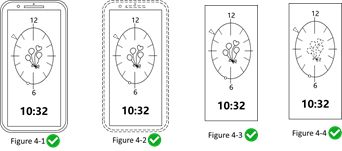
Figure 4-1 shows a whole design for protecting both a mobile phone and a GUI, and the design point lies in the GUI.
Figure 4-2 shows a partial design for protecting a GUI of a mobile phone.
Figure 4-3 shows a partial design for protecting a GUI of an electronic equipment.
Figure 4-4 shows a partial design for protecting part of a GUI of an electronic equipment.
4. Partial design protection does not apply to the designs of a set of products.
According to the new Guidelines, the designs in a design application including a set of products should be whole designs rather than partial designs.
It can be seen that the design application for a set of products is a relatively special type of design application in the design patent system, for which not only the similar design system is not applicable, but also the partial design system is not applicable.
5. Determination about whether a partial design is a "new design"
It is prescribed in the new Guidelines, during the preliminary examination, the examiner usually only needs to make a determination based on the content of the application documents and the common sense of ordinary consumers as to whether the claimed design meets the general requirement for a new design.
In practice, determination about whether the claimed part is a new design usually depends upon not only the partial design itself but also the product to which the partial design is applied, and the occupancy and proportion of the part in the entire product, etc. would be concerned for a comprehensive judgment.
II. Application Document Requirements for Partial Design
1. Drawings or photographs of partial designs
The new Guidelines impose higher requirements on drawings or photographs of designs. So far as the product with a three-dimensional design is concerned, if the essential features of the design of the product involve six sides, orthographic projection of six-side views should be submitted; if the essential features of the design of the product involve the view of one side or several sides only, orthographic projection view of the side concerned should be submitted, and for other side(s), either relevant orthographic projection view or perspective view should be submitted. For the side that is hard to be seen or cannot be seen when in use, its relevant view may be omitted, and the reason for the omission of this view should be indicated in the brief explanation.
In addition, for a partial design application, it should also be noted that the view showing the entire product, but not just the view only showing the part of the product to be protected, should be submitted by using a combination of solid lines for indicating the claimed part and dashed lines for indicating the disclaimed part, or by using other modes (such as covering the disclaimed part with a single colour translucent layer), so as to illustrate the claimed parts. Regardless of the claimed part or the disclaimed part, the corresponding projection relation among the views should be correct, and the contents of the views should be clearly identifiable.
That is, for protecting a partial design of a product, the views should show the entire product and can clearly distinguish the claimed part from the disclaimed part of the product, so as to not only clearly illustrate the claimed partial design but also clearly illustrate the position and proportion of this part in the entire product.
Moreover, if there is not a clear boundary line (so-called "physical boundary") between the claimed part and the disclaimed part, the boundary therebetween should be represented by a dotted-dashed line, which is an auxiliary means to clearly distinguish the claimed part from the other parts of the product. If the claimed part contains a three-dimensional shape, the submitted views shall include a perspective view for clearly showing the part.
2. Drafting requirements for brief description of partial design
(1) Title of the product
- Regarding a partial design of a general product (not involving GUI)
The title of the product in a partial design should include the name of the entire product and the name of the claimed part thereof, such as "a door for a car", "a camera of a mobile phone", "cup body" and "a main body of a fan".
- Regarding a partial design related to GUI in the form of the product to which the GUI is applied
If the part to be protected is a full GUI, the title of the product should include the specific purpose of the GUI and the name of the entire product to which the GUI is applied, as well as the keyword "graphical user interface". That is, the title of the product should involve three elements: the title of the entire product, GUI's function, and the keywords "graphical user interface", for example, "mobile payment graphical user interface for a mobile phone".
If the part to be protected is a part of the GUI, in addition to the specific purpose of the GUI, the name of the entire product to which the GUI is applied, and the keywords "graphical user interface", the title of the product should also involve the name of the claimed part of the product. That is, the title of the product should involve four elements: the title of the entire product, GUI's function, keywords "graphical user interface", and the name of the claimed part of the product, for example, "search bar of mobile payment graphical user interface for a mobile phone".
- Regarding a partial design related to GUI ("hereinafter also referred to as "GUI partial design") in the form of GUI itself without the product to which the GUI is applied
For a partial design related to GUI in the form of GUI itself without the product to which the GUI is applied, the name of the entire product should include the keyword "electronic equipment" in the title of the product. That is, the title of the product should involve four elements: the keywords "electronic equipment", GUI's function, the keywords "graphical user interface", and the name of the claimed part of the product, for example, "search bar of mobile payment graphical user interface for an electronic equipment ".
Additionally, for a dynamic graphical user, the title of the product should further involve an additional keyword, "dynamic".
(2) Usage of the Product
As to a whole design, the product usage drafted in a brief description should be helpful to define the product category. Regarding individual parts and components, the product to which they are applied should usually be stated, and if necessary, the usage of the product should be stated. Regarding a product with multiple usages, the multiple usages of the product should be stated.
As to partial design, in addition to complying with the requirements of the above-mentioned product usage for the whole design, the usage for the part of the product should also be stated, if necessary, corresponding to the usage mentioned in the title of the product.
When submitting a partial design related to GUI in the form of GUI itself without the product to which the GUI is applied, the usage of the product in the brief description can be generalized as an electronic device.
(3) Design points
Whether a whole design or a partial design, the essential features mean the shape, the pattern, their combination, the combination of the colour with the shape or pattern, or the position that is different from the prior design.
For partial design related to GUI, it should be stated in the brief description that the design points lie only in the GUI or part of the GUI, for example, the design point lies in the combination of shape and pattern, the design point lies in the headlights of a car, the design point lies in the graphical user interface, the design point lies in the graphical user interface, the design point lies in the dial part of the graphical user interface, or the like. Further, if necessary, the area of the graphical user interface in the product, the human-computer interaction method and the change process, etc., should be explained in the brief description.
Regarding design points, as the new Guidelines clearly state, the design referred to in the design brief description does not necessarily have a significant impact on the overall visual effect of the design and does not necessarily lead to significant differences between the patent involved and prior designs.
(4) Designated drawing or photograph that best illustrates the design point (i.e., representative drawings)
For a partial design, the designated drawing or photograph that best illustrates the design point should contain the partial design that is claimed.
Combined with the afore-mentioned provision that "if the part claimed for protection contains a three-dimensional shape, the submitted view shall include a three-dimensional view that clearly shows the part", for the partial design of a three-dimensional product, it is recommended to specify a three-dimensional view that can clearly show the part as the Representative diagram.
(5) Other explanation matters
In the brief description, in addition to general matters (for example, omitting a view of a side that is not easily visible or is invisible in use, requesting protection of colour, designating one design as the basic design in multiple similar designs, etc.), if a partial design application is prepared by using another expression way other than a combination of dashed and solid lines to represent the partial design to be protected, the claimed part shall be explained in the brief description.
If a dotted-dashed line is used to indicate a dividing line between the claimed part and other parts, this shall be stated in the brief description if necessary. If dashed lines are used to indicate the pattern design in the view, this should be stated in the brief description if necessary.
III. Unity of Partial Design Application
As prescribed, the multiple designs having unity in one design application should be whole or partial designs of the same product, and a basic design should be designated in the brief description, in comparison with which each of the other designs of the same product should be similar. Generally, in a multiple partial design application, after overall observation, if the basic design and other designs have the same or similar design features, and the difference between them lies in conventional changes such as the position and/or proportion of the partial design in the whole, etc., they are generally considered to be similar designs.
- Two or more unconnected partial designs of the same product can
be regarded as one design if they are related in function or design
concept to each other and form a specific visual effect.

Figure 5-1 shows a partial design for protecting the tails of a pair of temples, wherein unclaimed parts are covered with gray translucent colour blocks.
Figure 5-2 shows a partial design for protecting the lens and the tail of one temple wherein unclaimed parts are covered with gray translucent colour blocks (not allowed, the lens and the tail of the temple should be protected separately).
- Two or more partial designs of the same product with the same
protection scope do not meet the unity requirement.
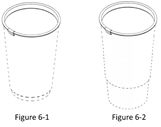
The designs in figures 6-1 and 6-2 each are a partial design for protecting a mouth of a cup. The protection scopes of them are the same but not similar and thereby do not meet the requirement of unity.
IV. Substantive Requirements for Divisional Application of Partial Design
The requirements for substantive content in a divisional application of a partial design are the same as those for a whole design. Usually the following requirements need to be met:
(1) If the parent application contains more than two designs, the divisional application shall contain one or several designs in the parent application and shall not exceed the scope indicated in the parent application. The so-called scope expressed in the parent application here can be understood as the protection scope of each design in the parent application. In other words, if the parent application only contains one design, there is no chance of submitting a divisional application.
(2) If the parent application includes a whole design of the product, it is not allowed to file parts of the whole design as a divisional application. For example, a design application seeks to protect the whole design of a motorcycle, if a divisional application is filed based on the whole design, only the whole design itself, but not parts or partial designs of the motorcycle, may be filed as a divisional application.
(3) Conversely, if the parent application includes a partial design of a product, the entire or other partial designs are not allowed to be filed as a divisional application based on this partial design.
It can be seen a design divisional application is strictly restricted within the original protection scopes of designs in the parent application, and any change in the subject matter or protection scope of the design divided from the parent application is not allowed.
V. Timing of Changing Protection Scope of Partial Design
After a design application is submitted, in addition to eliminating defects in the original application documents, the applicant may also have opportunities to modify the protection scope of the submitted design within the original contents, for example, (1) to modify a whole design to a partial design, (2) to modify a partial design into a whole design, or (3) to modify a certain partial design into another partial design in the same entire product. However, adding the number of designs is not allowed.
However, the voluntary amendment for modifying the protection scope is restricted to two months after submission. That is, changes between the partial design and the whole design or between different partial designs for the same entire product are allowed only during the voluntary amendment period of two months. If the voluntary amendment period is missed, it is impossible to make substantive amendments to change the protection scope.
In addition, if the original application is a first-filed application and it is still within the 6-month period for claiming this original application as a priority, there is also a possibility of modifying the protection scope of a design and adding new similar designs by submitting a new application and claiming the original application as a priority at the same time. When using this way, special attention should be paid to the fact that if the original application is a domestic application, after the priority is claimed, the original domestic application will be deemed to have been withdrawn.
VI. Examination Rules for Novelty and Inventiveness of Partial Design
The principles of the examination rules for novelty and inventiveness are basically the same for partial designs and whole designs and mainly include separate comparison, direct observation, the object of judgment only being the appearance of the product, and overall observation and comprehensive judgment. Although the examination principles for partial designs and whole designs are basically the same, there are somewhat different concerns and focuses between them in the comparative judgment of identity and similarity.
Generally, from the perspective of an ordinary consumer, it is necessary to consider whether the concerned design and the prior design belong to the same or similar category and find out the similarities and differences between the concerned design and the prior design to make a judgment whether there is a difference in the overall visual effect therebetween.
For a partial design, not only the category of the whole product but also the category of the claimed part will be concerned. The shape, pattern, and colour of the claimed part shall prevail, and the location and proportion of the claimed part in the product will be taken into consideration.
When compared with a prior design or combination of prior design features, generally, the prior design features that can be used for combination should be physically or visually naturally distinguishable designs with relatively independent visual effects, and points, lines, and planes randomly divided are not prior design features that can be used to combine and challenge the inventiveness of a whole design. However, if the concerned design is a partial design, the corresponding parts of the prior designs can be regarded as prior design features for combination.
Conclusion
Combined with the practical experiences of the partial design system for more than two years, it is not difficult to find that partial design has made up for the problem that innovation-creation points are not prominent to a certain extent from the perspective of a whole design, is helpful to focus on the specific design concept of the innovative subjects, accurately shows the innovative design points, and is conducive to promoting the comparative operations of subsequent administrative and judicial practices more convenient and objective.
Although the partial design puts forward specific requirements and rules for certain situations, it can be fully recognized that the whole design and the partial design advance shoulder to shoulder and complement each other, thereby forming a synergistic effect, effectively promoting the progress and perfection of the design protection system, and jointly establishing a perfect and flexible design protection system for protecting innovation-creation.
The author will continue to observe the performances of both partial designs and whole designs in the practices of design patent cases and judicial cases and is willing to share these topics in the future.
The content of this article is intended to provide a general guide to the subject matter. Specialist advice should be sought about your specific circumstances.

